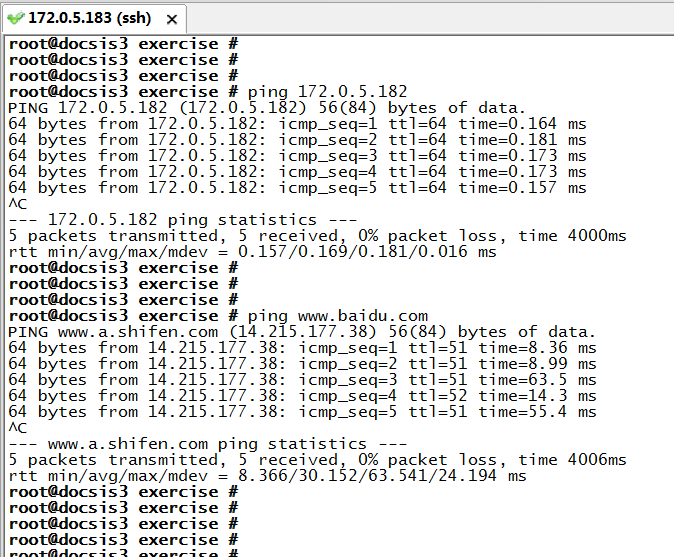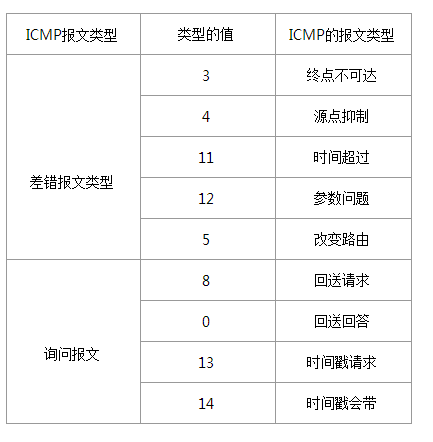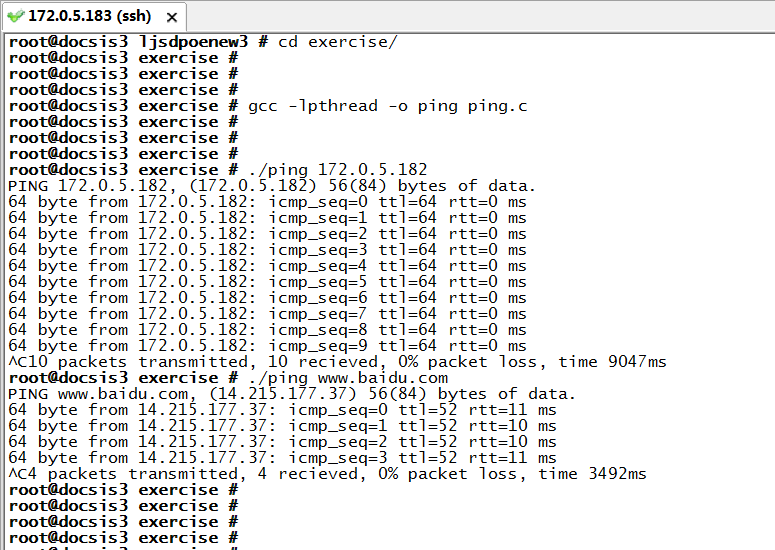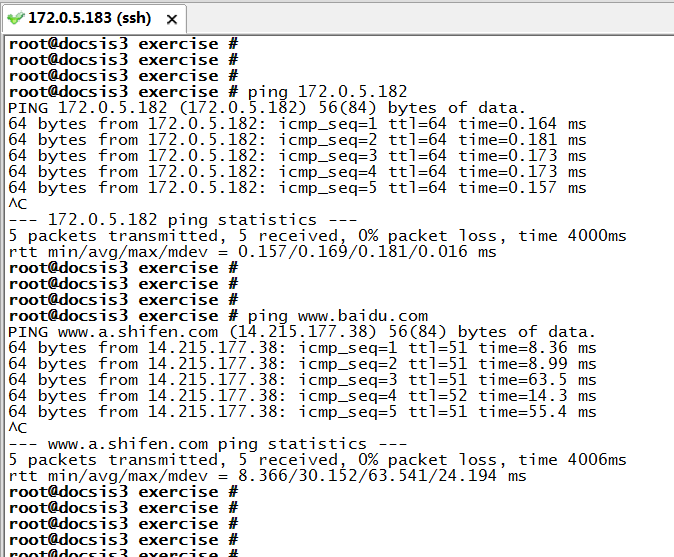Linux编程之PING的实现
PING(Packet InterNet Groper)中文名为因特网包探索器,是用来查看网络上另一个主机系统的网络连接是否正常的一个工具。ping命令的工作原理是:向网络上的另一个主机系统发送ICMP报文,如果指定系统得到了报文,它将把回复报文传回给发送者,这有点象潜水艇声纳系统中使用的发声装置。所以,我们想知道我这台主机能不能和另一台进行通信,我们首先需要确认的是我们两台主机间的网络是不是通的,也就是我说的话能不能传到你那里,这是双方进行通信的前提。在Linux下使用指令ping的方法和现象如下:

PING的实现看起来并不复杂,我想自己写代码实现这个功能,需要些什么知识储备?我简单罗列了一下:
- ICMP协议的理解
- RAW套接字
- 网络封包和解包技能
搭建这么一个ping程序的步骤如下:
- ICMP包的封装和解封
- 创建一个线程用于ICMP包的发送
- 创建一个线程用于ICMP包的接收
- 原始套接字编程



因为ICMP报文的具体格式会因为ICMP报文的类型而各不相同,我们ping包的格式是这样的:

void icmp_pack(struct icmp* icmphdr, int seq, int length)
{
int i = ; icmphdr->icmp_type = ICMP_ECHO; //类型填回送请求
icmphdr->icmp_code = ;
icmphdr->icmp_cksum = ; //注意,这里先填写0,很重要!
icmphdr->icmp_seq = seq; //这里的序列号我们填1,2,3,4....
icmphdr->icmp_id = pid & 0xffff; //我们使用pid作为icmp_id,icmp_id只是2字节,而pid有4字节
for(i=;i<length;i++)
{
icmphdr->icmp_data[i] = i; //填充数据段,使ICMP报文大于64B
} icmphdr->icmp_cksum = cal_chksum((unsigned short*)icmphdr, length); //校验和计算
}
这里简单介绍一下checksum(校验和)。
计算机网络通信时,为了检验在数据传输过程中数据是否发生了错误,通常在传输数据的时候连同校验和一块传输,当接收端接受数据时候会从新计算校验和,如果与原校验和不同就视为出错,丢弃该数据包,并返回icmp报文。
IP/ICMP/IGMP/TCP/UDP等协议的校验和算法都是相同的,采用的都是将数据流视为16位整数流进行重复叠加计算。为了计算检验和,首先把检验和字段置为0。然后,对有效数据范围内中每个16位进行二进制反码求和,结果存在检验和字段中,如果数据长度为奇数则补一字节0。当收到数据后,同样对有效数据范围中每个16位数进行二进制反码的求和。由于接收方在计算过程中包含了发送方存在首部中的检验和,因此,如果首部在传输过程中没有发生任何差错,那么接收方计算的结果应该为全0或全1(具体看实现了,本质一样) 。如果结果不是全0或全1,那么表示数据错误。
/*校验和算法*/
unsigned short cal_chksum(unsigned short *addr,int len)
{ int nleft=len;
int sum=;
unsigned short *w=addr;
unsigned short answer=; /*把ICMP报头二进制数据以2字节为单位累加起来*/
while(nleft>)
{
sum+=*w++;
nleft-=;
}
/*若ICMP报头为奇数个字节,会剩下最后一字节。把最后一个字节视为一个2字节数据的高字节,这个2字节数据的低字节为0,继续累加*/
if( nleft==)
{
*(unsigned char *)(&answer)=*(unsigned char *)w;
sum+=answer;
}
sum=(sum>>)+(sum&0xffff);
sum+=(sum>>);
answer=~sum;
return answer;
}
int icmp_unpack(char* buf, int len)
{
int iphdr_len;
struct timeval begin_time, recv_time, offset_time;
int rtt; //round trip time struct ip* ip_hdr = (struct ip *)buf;
iphdr_len = ip_hdr->ip_hl*;
struct icmp* icmp = (struct icmp*)(buf+iphdr_len); //使指针跳过IP头指向ICMP头
len-=iphdr_len; //icmp包长度
if(len < ) //判断长度是否为ICMP包长度
{
fprintf(stderr, "Invalid icmp packet.Its length is less than 8\n");
return -;
} //判断该包是ICMP回送回答包且该包是我们发出去的
if((icmp->icmp_type == ICMP_ECHOREPLY) && (icmp->icmp_id == (pid & 0xffff)))
{
if((icmp->icmp_seq < ) || (icmp->icmp_seq > PACKET_SEND_MAX_NUM))
{
fprintf(stderr, "icmp packet seq is out of range!\n");
return -;
} ping_packet[icmp->icmp_seq].flag = ;
begin_time = ping_packet[icmp->icmp_seq].begin_time; //去除该包的发出时间
gettimeofday(&recv_time, NULL); offset_time = cal_time_offset(begin_time, recv_time);
rtt = offset_time.tv_sec* + offset_time.tv_usec/; //毫秒为单位 printf("%d byte from %s: icmp_seq=%u ttl=%d rtt=%d ms\n",
len, inet_ntoa(ip_hdr->ip_src), icmp->icmp_seq, ip_hdr->ip_ttl, rtt); }
else
{
fprintf(stderr, "Invalid ICMP packet! Its id is not matched!\n");
return -;
}
return ;
}
void ping_send()
{
char send_buf[];
memset(send_buf, , sizeof(send_buf));
gettimeofday(&start_time, NULL); //记录第一个ping包发出的时间
while(alive)
{
int size = ;
gettimeofday(&(ping_packet[send_count].begin_time), NULL);
ping_packet[send_count].flag = ; //将该标记为设置为该包已发送 icmp_pack((struct icmp*)send_buf, send_count, ); //封装icmp包
size = sendto(rawsock, send_buf, , , (struct sockaddr*)&dest, sizeof(dest));
send_count++; //记录发出ping包的数量
if(size < )
{
fprintf(stderr, "send icmp packet fail!\n");
continue;
} sleep();
}
}
三、收包线程的搭建
我们同样建立一个接收包的线程,这里我们采用select函数进行收包,并为select函数设置超时时间为200us,若发生超时,则进行下一个循环。同样地,我们也需要一个全局变量来记录成功接收到的ping回复包的数量。
void ping_recv()
{
struct timeval tv;
tv.tv_usec = ; //设置select函数的超时时间为200us
tv.tv_sec = ;
fd_set read_fd;
char recv_buf[];
memset(recv_buf, ,sizeof(recv_buf));
while(alive)
{
int ret = ;
FD_ZERO(&read_fd);
FD_SET(rawsock, &read_fd);
ret = select(rawsock+, &read_fd, NULL, NULL, &tv);
switch(ret)
{
case -:
fprintf(stderr,"fail to select!\n");
break;
case :
break;
default:
{
int size = recv(rawsock, recv_buf, sizeof(recv_buf), );
if(size < )
{
fprintf(stderr,"recv data fail!\n");
continue;
} ret = icmp_unpack(recv_buf, size); //对接收的包进行解封
if(ret == -) //不是属于自己的icmp包,丢弃不处理
{
continue;
}
recv_count++; //接收包计数
}
break;
} }
}
void icmp_sigint(int signo)
{
alive = ;
gettimeofday(&end_time, NULL);
time_interval = cal_time_offset(start_time, end_time);
} signal(SIGINT, icmp_sigint);
#include <stdio.h>
#include <netinet/in.h>
#include <netinet/ip.h>
#include <netinet/ip_icmp.h>
#include <unistd.h>
#include <signal.h>
#include <arpa/inet.h>
#include <errno.h>
#include <sys/time.h>
#include <string.h>
#include <netdb.h>
#include <pthread.h> #define PACKET_SEND_MAX_NUM 64 typedef struct ping_packet_status
{
struct timeval begin_time;
struct timeval end_time;
int flag; //发送标志,1为已发送
int seq; //包的序列号
}ping_packet_status; ping_packet_status ping_packet[PACKET_SEND_MAX_NUM]; int alive;
int rawsock;
int send_count;
int recv_count;
pid_t pid;
struct sockaddr_in dest;
struct timeval start_time;
struct timeval end_time;
struct timeval time_interval; /*校验和算法*/
unsigned short cal_chksum(unsigned short *addr,int len)
{ int nleft=len;
int sum=;
unsigned short *w=addr;
unsigned short answer=; /*把ICMP报头二进制数据以2字节为单位累加起来*/
while(nleft>)
{
sum+=*w++;
nleft-=;
}
/*若ICMP报头为奇数个字节,会剩下最后一字节。把最后一个字节视为一个2字节数据的高字节,这个2字节数据的低字节为0,继续累加*/
if( nleft==)
{
*(unsigned char *)(&answer)=*(unsigned char *)w;
sum+=answer;
}
sum=(sum>>)+(sum&0xffff);
sum+=(sum>>);
answer=~sum;
return answer;
} struct timeval cal_time_offset(struct timeval begin, struct timeval end)
{
struct timeval ans;
ans.tv_sec = end.tv_sec - begin.tv_sec;
ans.tv_usec = end.tv_usec - begin.tv_usec;
if(ans.tv_usec < ) //如果接收时间的usec小于发送时间的usec,则向sec域借位
{
ans.tv_sec--;
ans.tv_usec+=;
}
return ans;
} void icmp_pack(struct icmp* icmphdr, int seq, int length)
{
int i = ; icmphdr->icmp_type = ICMP_ECHO;
icmphdr->icmp_code = ;
icmphdr->icmp_cksum = ;
icmphdr->icmp_seq = seq;
icmphdr->icmp_id = pid & 0xffff;
for(i=;i<length;i++)
{
icmphdr->icmp_data[i] = i;
} icmphdr->icmp_cksum = cal_chksum((unsigned short*)icmphdr, length);
} int icmp_unpack(char* buf, int len)
{
int iphdr_len;
struct timeval begin_time, recv_time, offset_time;
int rtt; //round trip time struct ip* ip_hdr = (struct ip *)buf;
iphdr_len = ip_hdr->ip_hl*;
struct icmp* icmp = (struct icmp*)(buf+iphdr_len);
len-=iphdr_len; //icmp包长度
if(len < ) //判断长度是否为ICMP包长度
{
fprintf(stderr, "Invalid icmp packet.Its length is less than 8\n");
return -;
} //判断该包是ICMP回送回答包且该包是我们发出去的
if((icmp->icmp_type == ICMP_ECHOREPLY) && (icmp->icmp_id == (pid & 0xffff)))
{
if((icmp->icmp_seq < ) || (icmp->icmp_seq > PACKET_SEND_MAX_NUM))
{
fprintf(stderr, "icmp packet seq is out of range!\n");
return -;
} ping_packet[icmp->icmp_seq].flag = ;
begin_time = ping_packet[icmp->icmp_seq].begin_time;
gettimeofday(&recv_time, NULL); offset_time = cal_time_offset(begin_time, recv_time);
rtt = offset_time.tv_sec* + offset_time.tv_usec/; //毫秒为单位 printf("%d byte from %s: icmp_seq=%u ttl=%d rtt=%d ms\n",
len, inet_ntoa(ip_hdr->ip_src), icmp->icmp_seq, ip_hdr->ip_ttl, rtt); }
else
{
fprintf(stderr, "Invalid ICMP packet! Its id is not matched!\n");
return -;
}
return ;
} void ping_send()
{
char send_buf[];
memset(send_buf, , sizeof(send_buf));
gettimeofday(&start_time, NULL); //记录第一个ping包发出的时间
while(alive)
{
int size = ;
gettimeofday(&(ping_packet[send_count].begin_time), NULL);
ping_packet[send_count].flag = ; //将该标记为设置为该包已发送 icmp_pack((struct icmp*)send_buf, send_count, ); //封装icmp包
size = sendto(rawsock, send_buf, , , (struct sockaddr*)&dest, sizeof(dest));
send_count++; //记录发出ping包的数量
if(size < )
{
fprintf(stderr, "send icmp packet fail!\n");
continue;
} sleep();
}
} void ping_recv()
{
struct timeval tv;
tv.tv_usec = ; //设置select函数的超时时间为200us
tv.tv_sec = ;
fd_set read_fd;
char recv_buf[];
memset(recv_buf, ,sizeof(recv_buf));
while(alive)
{
int ret = ;
FD_ZERO(&read_fd);
FD_SET(rawsock, &read_fd);
ret = select(rawsock+, &read_fd, NULL, NULL, &tv);
switch(ret)
{
case -:
fprintf(stderr,"fail to select!\n");
break;
case :
break;
default:
{
int size = recv(rawsock, recv_buf, sizeof(recv_buf), );
if(size < )
{
fprintf(stderr,"recv data fail!\n");
continue;
} ret = icmp_unpack(recv_buf, size); //对接收的包进行解封
if(ret == -) //不是属于自己的icmp包,丢弃不处理
{
continue;
}
recv_count++; //接收包计数
}
break;
} }
} void icmp_sigint(int signo)
{
alive = ;
gettimeofday(&end_time, NULL);
time_interval = cal_time_offset(start_time, end_time);
} void ping_stats_show()
{
long time = time_interval.tv_sec*+time_interval.tv_usec/;
/*注意除数不能为零,这里send_count有可能为零,所以运行时提示错误*/
printf("%d packets transmitted, %d recieved, %d%c packet loss, time %ldms\n",
send_count, recv_count, (send_count-recv_count)*/send_count, '%', time);
} int main(int argc, char* argv[])
{
int size = *;//128k
struct protoent* protocol = NULL;
char dest_addr_str[];
memset(dest_addr_str, , );
unsigned int inaddr = ;
struct hostent* host = NULL; pthread_t send_id,recv_id; if(argc < )
{
printf("Invalid IP ADDRESS!\n");
return -;
} protocol = getprotobyname("icmp"); //获取协议类型ICMP
if(protocol == NULL)
{
printf("Fail to getprotobyname!\n");
return -;
} memcpy(dest_addr_str, argv[], strlen(argv[])+); rawsock = socket(AF_INET,SOCK_RAW,protocol->p_proto);
if(rawsock < )
{
printf("Fail to create socket!\n");
return -;
} pid = getpid(); setsockopt(rawsock, SOL_SOCKET, SO_RCVBUF, &size, sizeof(size)); //增大接收缓冲区至128K bzero(&dest,sizeof(dest)); dest.sin_family = AF_INET; inaddr = inet_addr(argv[]);
if(inaddr == INADDR_NONE) //判断用户输入的是否为IP地址还是域名
{
//输入的是域名地址
host = gethostbyname(argv[]);
if(host == NULL)
{
printf("Fail to gethostbyname!\n");
return -;
} memcpy((char*)&dest.sin_addr, host->h_addr, host->h_length);
}
else
{
memcpy((char*)&dest.sin_addr, &inaddr, sizeof(inaddr));//输入的是IP地址
}
inaddr = dest.sin_addr.s_addr;
printf("PING %s, (%d.%d.%d.%d) 56(84) bytes of data.\n",dest_addr_str,
(inaddr&0x000000ff), (inaddr&0x0000ff00)>>,
(inaddr&0x00ff0000)>>, (inaddr&0xff000000)>>); alive = ; //控制ping的发送和接收 signal(SIGINT, icmp_sigint); if(pthread_create(&send_id, NULL, (void*)ping_send, NULL))
{
printf("Fail to create ping send thread!\n");
return -;
} if(pthread_create(&recv_id, NULL, (void*)ping_recv, NULL))
{
printf("Fail to create ping recv thread!\n");
return -;
} pthread_join(send_id, NULL);//等待send ping线程结束后进程再结束
pthread_join(recv_id, NULL);//等待recv ping线程结束后进程再结束 ping_stats_show(); close(rawsock);
return ; }
我的实验环境是两台服务器,发起ping的主机是172.0.5.183,被ping的主机是172.0.5.182,以下是我的两次实验现象(ping IP和ping 域名)。
只有root用户才能利用socket()函数生成原始套接字,要让Linux的一般用户能执行以上程序,需进行如下的特别操作:用root登陆,编译以上程序gcc -lpthread -o ping ping.c



Linux编程之PING的实现的更多相关文章
- Linux编程之ICMP洪水攻击
我的上一篇文章<Linux编程之PING的实现>里使用ICMP协议实现了PING的程序,ICMP除了实现这么一个PING程序,还有哪些不为人知或者好玩的用途?这里我将介绍ICMP另一个很有 ...
- 【转】 linux编程之GDB调试
GDB是一套字符界面的程序集,可以用它在linux上调试C和C++程序,它提供了以下的功能: 1 在程序中设置断点,当程序运行到断点处暂停 2 显示变量的值,可以打印或者监视某个变量,将某个变量的值显 ...
- Linux编程之UDP SOCKET全攻略
这篇文章将对linux下udp socket编程重要知识点进行总结,无论是开发人员应知应会的,还是说udp socket的一些偏僻知识点,本文都会讲到.尽可能做到,读了一篇文章之后,大家对udp so ...
- Linux编程之epoll
现在有这么一个场景:我是一个很忙的大老板,我有100个手机,手机来信息了,我的秘书就会告诉我"老板,你的手机来信息了."我很生气,我的秘书就是这样子,每次手机来信息就只告诉我来信息 ...
- Linux编程之fork函数
在Linux中,fork函数的功能就是在一个进程中创建一个新的进程,当前调用fork函数的进程就是产生的新进程的父进程,新进程在以下也称为子进程.在新进程生成之后就会在系统中开始执行. 函数原型:pi ...
- 【转】Linux编程之UDP SOCKET全攻略
转自:http://www.cnblogs.com/skyfsm/p/6287787.html?utm_source=itdadao&utm_medium=referral 这篇文章将对lin ...
- linux编程之GDB调试
GDB是一套字符界面的程序集,可以用它在linux上调试C和C++程序,它提供了以下的功能: 1 在程序中设置断点,当程序运行到断点处暂停 2 显示变量的值,可以打印或者监视某个变量,将某个变量的值显 ...
- 网络编程之ping
#include <sys/types.h>#include <netinet/ip.h>#include <netdb.h>#include<arpa/in ...
- Linux编程之select
select系统调用的的用途是:在一段指定的时间内,监听用户感兴趣的文件描述符上可读.可写和异常等事件. select 机制的优势 为什么会出现select模型? 先看一下下面的这句代码: int i ...
随机推荐
- CentOS tengine mysql 5.7 php 5.6
CentOS 7.x 编译安装 LNMP L 版本是 CentOS 7.x x64版本, N 我们使用tengine 的最新版本,主要原因是因为tengine 默认支持很多的模块. M 这里我们选用 ...
- arrayList LinkedList HashMap HashTable的区别
ArrayList 采用的是数组形式来保存对象的,这种方式将对象放在连续的位置中,所以最大的缺点就是插入删除时非常麻烦 LinkedList 采用的将对象存放在独立的空间中,而且在每个空间中还保存下一 ...
- (简单) POJ 3264 Balanced Lineup,RMQ。
Description For the daily milking, Farmer John's N cows (1 ≤ N ≤ 50,000) always line up in the same ...
- Quartz.NET总结(一)
Quartz.NET总结(一) 前段时间,花了大量的时间,将原先的计划任务,切换到Quartz.NET来进行管理.原先的后台定时服务都是通过计划任务来实现的,但是随着业务增长,计划任务也越来越多,每个 ...
- MySQL 同步状态
Exec_Master_Log_Pos: The position of the last event executed by the SQL thread from the master's bin ...
- photoshop如何快速切图
作为业余爱好,之前都是用比较笨的方法切图,甚至用裁剪工具一张一张的切. 后来知道用切片工具,但也仅限于互不重叠的图片. 在工作中实际使用时才发现实在是太慢了,慢到上级自己说你不用做了,我来吧. 其实, ...
- mongodb 3.x connect with credential
package mongoDb; import java.net.UnknownHostException; import java.util.ArrayList; import java.util. ...
- Android源码编译jar包BUILD_JAVA_LIBRARY 与BUILD_STATIC_JAVA_LIBRARY的区别(二)
上文简单介绍了BUILD_JAVA_LIBRARY 与BUILD_STATIC_JAVA_LIBRARY编译出来jar包的区别, 那么你如果拿到了一个内容是dex格式的jar包,而你又偏偏需要这个ja ...
- LPC1768的iic通讯
LPC1768有三路IIC,其中IIC0支持高速模式和plus模式,另外两路是普通IIC,使用IIC的过程如下 首先依然是打开IIC时钟,同时打开GPIO时钟 然后配置引脚为IIC功能 另外,因为ii ...
- UVa 483 - Word Scramble
题目大意:给一个由单词组成的句子,只反转单词内部的次序而不改变单词之间的次序.如“I love you.”转换成“I evol .uoy”. #include <cstdio> #incl ...
